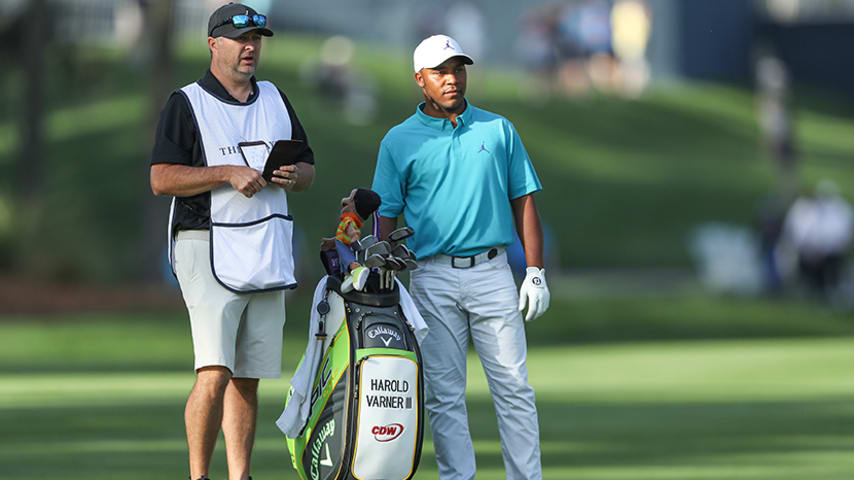The logical explanation behind Sunday’s closing pin placements at THE PLAYERS
8 Min Read

PONTE VEDRA BEACH, FL - MAY 15: Jason Day of Australia smiles while walking up the 18th hole fairway with his caddie Colin Swatton during the final round of THE PLAYERS Championship on THE PLAYERS Stadium Course at TPC Sawgrass on May 15, 2016. (Photo by Keyur Khamar/PGA TOUR)
The logical explanation behind Sunday’s closing pin placements at THE PLAYERS Championship
The logical explanation behind Sunday’s closing pin placements at THE PLAYERS Championship
PONTE VEDRA BEACH, Fla. – Three paces.
That’s all you get on the right of the flag on Sunday at TPC Sawgrass on the iconic 17th island hole.
Any more than three and your ball faces a watery grave.
The traditional back right pin placement has been a staple for years at THE PLAYERS Championship -- so much so that when the man who sets up the course took the job, he was told it was non-negotiable.
It is part of the three-hole gauntlet that allows a player to come home with a serious flourish should they step up and execute under the final-round pressure.
But don’t be off … because if you are, your chances at becoming PLAYERS champion could drown in Pete Dye’s lakes.
For the seventh year in a row, Sunday’s pin placements on the final three holes at TPC Sawgrass will be in their traditional “risk-reward” spots.
On the par-5 16th, this means the front right quadrant, 17 paces from the front and four paces from the right edge that’s guarded by water.
The par-3 17th is 14 paces from the front and three from the right.
The par-4 closing 18th is just eight paces on and four from the left -- where once again water sits.
The similarities among the pin positions are a very deliberate ploy from officials. No matter what the scenario on the leaderboard … this thing ain’t over till it’s over.
“You can stand on the 16th tee three or four shots behind and still have a chance to win the golf tournament,” says PGA TOUR rules official Robby Ware.
In the early hours before Saturday’s third round, Ware and Vice President of Rules and Competition Mark Russell are marking Sunday’s pins with a white dot and hitting a few putts towards each location to ensure everything looks in order.
It is routine for officials to not only set the hole for the current round, but to also mark where the next round intends to be. This is why you often see caddies stalking out areas of greens their player isn’t actually putting towards.
Ware was a big part of 18’s traditional Sunday placement being moved away from what used to be a much more difficult back left.
“The one thing I was told when I took over set-up was that it was non-negotiable that the hole was going to be back right on 17 on Sunday and it was going to be back left on 18,” recalls Ware, who is now in his 12th year in in his current position.
“But when we did a greens reconstruction, I talked them in to levelling out the front left area at 18 because I thought that would be a more exciting hole placement than the back left. The back left is so hard to make birdies. Guys hit it in the middle of the green or they hit it long and they make par.
“I wanted to design that part of the green so the balls would actually funnel down towards the hole where a guy could make a birdie and win the golf tournament.”
Ware says the idea for the last three holes is quite simply to create volatility and excitement. This Saturday morning, despite the fact the first group won’t come through the stretch for three hours yet, fans already have claimed their patch of grass in the amphitheater.
On Sunday, they come in even earlier.
“The theme of these locations is excitement for sure,” Ware adds. “Where great shots are rewarded and if you hit poor shots, you can make a big number. Let’s face it – it’s why all these people want to be around here.”
Creating excitement is exactly what Rickie Fowler was able to do on Sunday in 2015. Sitting well back coming down the stretch, Fowler finished eagle-birdie-birdie. It pushed him into a three-hole aggregate playoff – which is, of course, played on the final three holes – with Sergio Garcia and Kevin Kisner.
It took four playoff holes, but Fowler prevailed. He ended making birdie three times in one day on the 17th as he took dead aim.
Asked about the Sunday pins, Fowler smiles. “They’re great locations. They’ve been fun for me,” he says. “A lot can happen. It can go either way. Someone can make a three on 16 as easy as they can make six. There is a lot of risk-reward involved. And that’s great.
“You can chase the leader and if you have a two-shot lead going into the last three holes, you know it is not safe as guys can put low numbers up.”
So what exactly is the play on each hole to get the most reward for your risk?
The 16th pin
“On the 16th you can aim at the middle of the green on your approach and it can feed to the hole, so really it puts the pressure on the tee shot,” Marc Leishman explains. “You need to find the fairway.”
But even doing that doesn’t bring immediate ease.
If you are on the right side of the fairway or even towards the middle of it, the long approach shot carries a significant amount of water. The landing area to find the funnel towards the hole is quite generous, perhaps 20 feet or more left of the pin, but that’s easier said than done with a tournament on the line.
“You just have to man up and hit a good shot to get the reward,” 2004 PLAYERS champion Adam Scott says.
“The pin sits in the bowl but it is also close to the water so there is reward there if you are in the vicinity of the pin,” adds 2012 PLAYERS champ Matt Kuchar, “but if you bail out and steer clear of water it can be a tricky chip -- even though you have some green to work with.”
The 17th pin
If you think pressure is applied on 16, well, 17 takes it up a notch. Sure, it’s just a short par 3. Sure, it’s a wedge most times. And sure, there is a little more than 20 yards to the left of the pin to play with on Sunday’s pin at 17.
But if you need a birdie, anything more than four paces left of the flag means you won’t catch the slope that sends the ball towards the hole.
And if you’re taking dead aim … your depth target sits within 10 paces because the island is not a perfect circle. If you’re short, you might get lucky and find the tiny bunker. If not, you’re likely wet.
“It just depends on the wind. If it is not very windy, it is a 145-yard shot. Theoretically it is not very hard. But when you get a chance to win the tournament or you get some wind off the right, it’s a pretty tough shot,” 2017 FedExCup champion Justin Thomas says.
“The thing is, though, if you don’t get it down on that slope, it’s a quick putt. If you are stuck down the front of the green or anywhere above the slope, it’s tough, speed-wise.”
One man who knows the agony and ecstasy of Sunday’s 17th pin is 2008 champion Sergio Garcia. It was pivotal in his win over Paul Goydos, but in 2013 as he chased down Tiger Woods, Garcia came up short twice going for the glory.
“It’s not a long club but you are not going right of the hole -- you are trying to hit left,” Garcia explains. “You need to control your distance. You have about four yards to catch the slope. It’s not a massive target but it’s a short club. The last few holes of a tournament certainly adds pressure to it though.”
For Jason Day, the 2016 champion, the key is mental discipline.
“It’s got more risk than reward,” Days says about the final-round pin location. “But you stand up there with a wedge in your hand and you feel like you can hit it close.”
“You have to remember there is an intimidation factor. To the right you are souping it, if you are short, you have a tough putt. The smart play is to be left and on the top shelf and hope you can make a putt.”
The 18th pin
As for the closing hole … once again the tee shot can be critical as water protects the entire left side. If you bail too far right, you have rough and trees to contend with.
An approach roughly 20 feet right of the pin will still catch the slope and feed the ball in close, so there’s no need to be super-aggressive. But if you miss the mark to the left, you’re wet. Short leaves a tricky pitch off a tight lie. Long or too far right and you have to judge the downhill speed to perfection.
“They provide a lot of fireworks in the last three holes and that’s what you want when you’re playing a tournament of this caliber,” Garcia adds.
“They’re perfect. It is supposed to provide theatre,” adds Day. “It means you come down the stretch still confident you can make a big move. You’re not dead yet. Or if in front, you’re not totally safe yet. It has you thinking.”
Ware hopes the locations will stay for years to come.
“What Rickie did – that’s what you set it up for. That was so great to see,” he says. “Obviously the players hit the shots, but you set up the hole locations knowing if a guy hits a great shot, he is going to be rewarded for it.
“We think we’ve ensured that.”
They certainly have. So sit back, relax and get ready for the annual fireworks.






